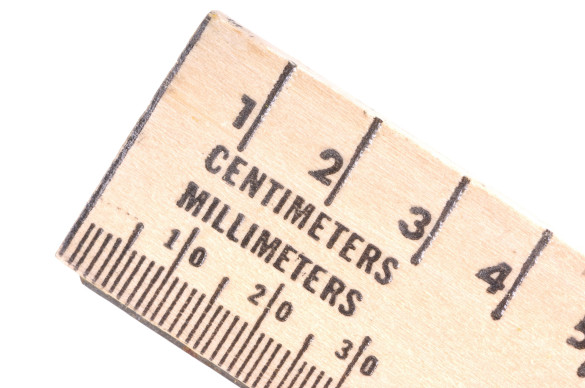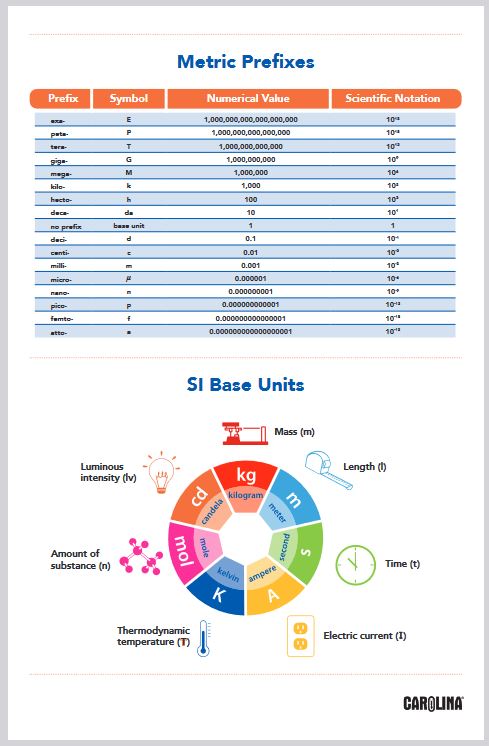SI/METRIC BASE UNITS
In the United States, measurements are generally provided in English units. For example, when driving to a nearby town to see a friend or family member, we may say “it’s 20 miles from here.” In many parts of the world, a person referring to the same distance may say “it’s 32 kilometers from here.” People who use the term “kilometer” to describe distance are employing the metric system.
The metric system, or more accurately the International System of Units (SI), is an international system of measurement and the unit system most often used in STEM (science, technology, engineering, and math). Scientists around the world use and understand the SI. (In writing, “S” appears before “I” because in French the “International System of Units” is written “Systѐme International d’Unités” [Bryant 1976]).
Unlike the English system of units that uses different names and unit sizes for volumes (e.g., gallons, pints, quarts), weights (e.g., pounds, stones, tons, short tons, long tons), and distances (e.g., feet, yards, miles), the SI uses the same base units and the same prefixes for all types of measurements.
Prefixes are provided in scales that function around 7 units known as metric system (or SI) base units. As shown in Table 1, base units include the meter (m), the kilogram (kg), the kelvin (K), the second (s), the ampere (A), the candela (cd), and the mole (mol).
Table 1 Metric base units, abbreviations, and reference standards (Helmenstine n.d.).
| SI/METRIC BASE UNITS | |||
| SI Term | What It Measures | Abbreviation | Reference Standard |
| meter | length | m | The length a path of light travels in a vacuum in 1/299,792,458 seconds (speed of light (c) = 299,792,458 m/s). |
| kilogram | mass | kg | The fixed numerical value of the Planck constant h to be 6.62607015 x10-34 when expressed in the unit J s, which is equal to kg m2 s-1 where the meter and the second are defined in terms of c and Δ vCs. |
| kelvin | temperature | K | The fraction 1/273.16 of the thermodynamic temperature of the triple point of water (273.16 K = 0.01° C). |
| second | time | s | The duration of 9,192,631,770 periods of radiation, which is the difference in the transition between the levels of the cesium-133 atomic ground state. |
| ampere | current | A | A constant current maintained in 2 straight, parallel, non-negligible conductors of infinite length placed 1 meter apart in a vacuum that produces a force between them of 2 x 10–7 newtons (N) per meter (1 N = 1 kg x m2 x s–2). |
| candela | luminous intensity | cd | A source emitting monochromatic radiation of frequency 540 x 1012 hertz with a radiant intensity in the same direction of 1/683 watt per steradian. |
| mole | amount of substance | mol | The number of atoms in 0.012 kilograms of carbon-12. |
Table 2 Commonly used non-SI units (National Institute of Standards and Technology n.d.; K. Mace, personal knowledge; conversions from OnlineConversion.com n.d.).
| COMMONLY USED NON-SI UNITS | |||
| Unit | Symbol | Commonly Used Equivalents | Common Uses |
| Time | |||
| minute | min | 1 min = 60 s | Calculations involving time |
| hour | h | 1 h = 60 min = 3,600 s | Calculations involving time |
| day | d | 1 d = 24 h = 1,440 min = 86,400 s | Calculations involving time |
| Navigation | |||
| degree (angle) | ° | 1° = (π/180) radians | Longitude, latitude |
| minute (angle) | ' | 1' = (1/60)° = (π/10,800) radians | Longitude, latitude |
| second (angle) | " | 1" = (1/60)' = (π/648,000) radians | Longitude, latitude |
| Volume | |||
| liter | L | 1 L = 1 dm3 = 0.001 m3 = 1000 cm3 | Calculating volumes smaller than ocean-sized |
| centimeter cubed | cc | 1 cc = 1 mL | Medical applications, small volume calculations |
| sverdrup | Sv | 1 Sv = 1 million cubic meters per second | Calculating volumes of water in the world oceans |
| Mass | |||
| pound | lb | 1 lb = 0.4536 kg = 16 oz | Masses of food, people, animals, etc., in the US |
| ounce | oz | 16 oz = 1 lb | Masses of food, people, animals, etc., in the US |
| short ton | ton | 1 ton = 2,000 lb = 907.2 kg | Shipping, manufacturing, etc., in the US |
| long ton or "imperial ton" | t | 1 t = 1,016 kg = 2240 pounds | Shipping, manufacturing, etc., in the US and globally |
| metric ton or tonne | t | 1 t = 1,000 kg = 1 Mg = 2204.6 pounds | Shipping, manufacturing, etc., in the US and globally |
| unified atomic mass unit |
u (Da) | 1 u = 1.6605 x 10–27 kg | Measuring the size of atoms |
| Energy | |||
| electronvolt | eV | 1 eV = 1.602176 x 10–19 J | Calculating the energy of particles streaming to Earth from the Sun, high-energy physics/particle physics, etc. |
| joule | J | 1 J = 1 kg x m2 x s–2 = 2.78 x 10–7 kWh | Scientific publications, oil and gas industry |
| British thermal unit | BTU | 1 BTU = 1,055.06 J = 252.16 Cal | Electric utilities, oil and gas industry, machinery |
| calorie | cal | 1 calorie = 4.184 J | Chemistry and physics measurements |
| Calorie | Cal | 1 Cal = 1,000 calories | Food and drink packaging |
| newton | N | 1 N = 1 kg x m x s–2 | Force calculations, anchors, fasteners, thrust of rockets, etc. |
| Power | |||
| watt | W | 1 W = 1 J x s–1 = 1 N x m x s–1 = 1 kg x m2 x s–3 |
Electric power generation and delivery, radio transmission |
| horsepower | HP | 1 HP = 745.7 watts | Automobile, truck, and machine engine ratings |
| Distance | |||
| nautical mile | nm, NM, M | 1 nautical mile (NM) = 1,852 m | Shipping, sea navigation, ocean mapping, military operations |
| knot | kn | 1 knot = 1 nautical mile (NM)/hour = 1.151 miles/hour | Shipping, sea navigation, military operations |
| mile | m | 1 m = 5,280 ft = 1.609 km | Highway signs, navigation, etc., in the US |
| foot | ft | 1 ft = 0.3048 m | Construction, textiles, assembly, etc., in the US |
| yard | yd | 1 yd = 3 ft = 0.9144 m | Construction, textiles, assembly, etc., in the US |
| Area | |||
| hectare | ha | 1 ha = 2.47 acres = 10,000 m2 | Scientific publications in ecology, international land development, etc. |
| acre | a | 1 acre = 43,560 square feet = 4,047 m2 | Real estate, English language documents describing areas |
| Pressure | |||
| pascal | Pa | 1 Pa = 1 N/m2 = 1 kg x m x s–2 = 1 J x m–3 |
Official scientific publications (shown as hectopascal [hPa]), weather forecasting, oceanography, military applications, etc. |
| atmosphere | atm | 1 atm = 10,1325 Pa = 760 mmHg = 1,013 mbar = 760 torr |
Weather forecasting, military applications, scientific publications, etc. |
| millibar | mbar | 1 mbar = 100 Pa = 0.000987 atm | Weather forecasting, military applications, etc. |
| millimeter of mercury | mmHg | 1 mmHg = 1.33 mbar = 133.32 Pa | Scientific publications, weather forecasting |
| torr | torr | 1 torr = 133 Pa = 0.0013 atm | Scientific publications |
| Temperature | |||
| Fahrenheit | °F | °F = °C x (9/5) + 32 K = (5/9) (°F – 32) + 273.15 |
Scientific documents, US weather forecasts, appliances, machinery, and food packaging in the US, etc. |
| Celsius | °C | °C = K – 273.15 | Scientific documents; European, Middle Eastern, and Asian weather forecasts; appliances; machinery; food packaging outside the US; etc. |
When you report data in metric (SI) or non-metric (non-SI) units, it is often necessary to use a prefix so numbers are not extremely large or extremely small when written. As examples of how scientists use units in their work, consider the following:
- Most bacteria are 0.0000002 to 0.00001 meters in length (Carter n.d.). Instead of expressing the length as 0.0000002 meters, we could write 2 x 10–7 meters (in scientific notation) or 0.2 µm (pronounced “micrometers”). Note: Although “micron,” which denoted the micrometer, was part of the scientific vernacular for many years, the term is no longer accepted in academic science circles. The mathematical transition is, as follows, based on the SI prefixes provided in Table 3:

- NASA (National Aeronautics and Space Administration) and NOAA (National Oceanic and Atmospheric Administration) often report the units of carbon flowing into and out of the atmosphere, the terrestrial biosphere, and the oceans, and carbon stocks in units of gigatons (a non-SI unit with a metric prefix) (Riebeek 2011). In NASA’s and NOAA’s carbon maps, the largest carbon reservoir on Earth is located in the deep ocean (below the level of photosynthesis and respiration). NASA and NOAA assign a value of 37,000 gigatons to this carbon reservoir. In tons this is:

Note that this is an example of a non-metric (or non-SI) unit used with the metric prefixes shown in Table 3. Many of the non-SI units shown in Table 2 are often used in this way—especially in earth science, physical science, and engineering.
Table 3 Metric (SI) prefixes.
| METRIC (SI) PREFIXES | |||
| Prefix (Symbol) | Formation | Number | Often Stated as… |
| yotta (Y) | yotta + BASE UNIT | 1024 | 1 septillion |
| zetta (Z) | zeta + BASE UNIT | 1021 | 1 sextillion |
| exa (E) | exa + BASE UNIT | 1018 | 1 quintillion |
| peta (P) | peta + BASE UNIT | 1015 | 1 quadrillion |
| tera (T) | tera + BASE UNIT | 1012 | 1 trillion |
| giga (G) | giga + BASE UNIT | 109 | 1 billion |
| mega (M) | mega + BASE UNIT | 106 | 1 million |
| kilo (K) | kilo + BASE UNIT | 103 | 1 thousand |
| hecto (h) | hecto + BASE UNIT | 102 | 1 hundred |
| deka (da) | deka + BASE UNIT | 101 | 1 ten |
| BASE | BASE UNIT | 100 | BASE UNIT |
| deci (d) | deci + BASE UNIT | 10–1 | 1 tenth |
| centi (c) | centi + BASE UNIT | 10–2 | 1 hundredth |
| milli (m) | milli + BASE UNIT | 10–3 | 1 thousandth |
| micro (µ) | micro + BASE UNIT | 10–6 | 1 millionth |
| nano (n) | nano + BASE UNIT | 10–9 | 1 billionth |
| pico (p) | pico + BASE UNIT | 10–12 | 1 trillionth |
| femto (f) | femto + BASE UNIT | 10–15 | 1 quadrillionth |
| atto (a) | atto + BASE UNIT | 10–18 | 1 quintillionth |
| zepto (z) | zepto + BASE UNIT | 10–21 | 1 sextillionth |
| yocto (y) | yocto + BASE UNIT | 10–24 | 1 septillionth |
References
Bryant, S. 1976. Système international d’unités. The Australian and New Zealand Journal of Surgery 46(3): 266–8. https://www.ncbi.nlm.nih.gov/pubmed/1070306 (accessed March 13, 2017).
Carter, P. n.d. Functional anatomy of prokaryotic and eukaryotic cells.
http://classes.midlandstech.edu/carterp/courses/bio225/chap04/lecture2.htm
(accessed February 28, 2017, and March 13, 2017).
Helmenstine, A.M. 2017. Metric units—base units: Seven basic metric measurements. https://www.thoughtco.com/metric-units-base-units-604140 (accessed February 28, 2017, and March 13, 2017).
NIST (National Institute of Standards and Technology). n.d. International System of Units (SI): Units outside the SI. http://physics.nist.gov/cuu/Units/outside.html (accessed February 28, 2017, and March 13, 2017).
OnlineConversion.com. n.d. Welcome to OnlineConversion.com. http://www.onlineconversion.com/ (accessed February 28, 2017; March 6, 2017; and March 13, 2017).
Riebeek, H. 2011. The carbon cycle. https://earthobservatory.nasa.gov/Features/CarbonCycle/ (accessed February 29, 2017, and March 13, 2017).
*Next Generation Science Standards® is a registered trademark of Achieve. Neither Achieve nor the lead states and partners that developed the Next Generation Science Standards were involved in the production of, and do not endorse, these products.



